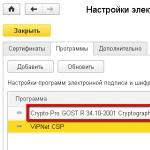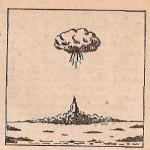Presentation on the topic "Carbon dioxide (CO2)". Presentation on the topic "Carbon dioxide (CO2)" Presentation on the topic carbon dioxide
Slide 1
Carbon dioxide
Slide 2

Molecule structure
The CO2 molecule is linear, the length of the C=O double bond is 0.116 nm.
Within the framework of the theory of hybridization of atomic orbitals, two σ bonds are formed by the sp-hybrid orbitals of the carbon atom and the 2p orbitals of the oxygen atom. Carbon p-orbitals that do not participate in hybridization form p-bonds with similar oxygen orbitals. The molecule is non-polar.

Slide 3
Physical properties
Carbon monoxide (IV) is carbon dioxide, a colorless and odorless gas, heavier than air, soluble in water, and upon strong cooling it crystallizes in the form of a white snow-like mass - “dry ice”. At atmospheric pressure it does not melt, but evaporates; the sublimation temperature is -78 °C. Carbon dioxide is formed when organic matter rots and burns. Contained in the air and mineral springs, released during the respiration of animals and plants. Slightly soluble in water (1 volume of carbon dioxide in one volume of water at 15 ° C).

Slide 4
Chemical properties
Chemically, carbon monoxide is inert.

Slide 4
1. Oxidizing properties With strong reducing agents at high temperatures it exhibits oxidizing properties. Coal is reduced to carbon monoxide: C + CO2 = 2CO.
Magnesium ignited in air continues to burn in an atmosphere of carbon dioxide: 2Mg + CO2 = 2MgO + C.

Slide 4
Slide 5
2. Properties of acid oxide Typical acid oxide. Reacts with basic oxides and bases, forming carbonic acid salts: Na2O + CO2 = Na2CO3, 2NaOH + CO2 = Na2CO3 + H2O, NaOH + CO2 = NaHCO3.

Slide 6
3. Qualitative reaction A qualitative reaction for detecting carbon dioxide is the turbidity of lime water: Ca(OH)2 + CO2 = CaCO3↓ + H2O. At the beginning of the reaction, a white precipitate is formed, which disappears when CO2 is passed through lime water for a long time, because insoluble calcium carbonate turns into soluble bicarbonate: CaCO3 + H2O + CO2 = Ca(HCO3)2.
Slide 7

Getting sugar. Fire extinguishing. Production of fruit waters. "Dry ice". Obtaining cleaning supplies. Receiving medications. Preparation of soda, which is used to make glass.
Applications of carbon monoxide (IV)
Slide 9

Combustion is associated with the appearance of smoke. The smoke can be white, black, and sometimes invisible. An “invisible” smoke called carbon dioxide rises above a hot candle or alcohol lamp.
Hold a clean test tube over the candles and catch a little of the “invisible” smoke.
To prevent it from flying away, quickly close the test tube with a stopper without a hole. Carbon dioxide will be invisible in a test tube. Save this test tube with carbon dioxide for further experiments.

We're catching smoke
Slide 10
"Muddy Story"

Pour a little lime water (to cover the bottom) into the test tube in which you captured the carbon dioxide from the candle flame. Close the test tube with your finger and shake it. The clear lime water became completely cloudy. Only carbon dioxide is to blame for this. If you take lime water into a test tube that does not contain carbon dioxide, and shake the test tube, the water will remain clear. This means that the turbidity of the limewater is evidence that there was carbon dioxide in the test tube.
Slide 11
Carbon dioxide is released from soda

Take some soda powder and heat it in a horizontal reinforced test tube. Connect this test tube with an elbow tube to another test tube containing water. Bubbles will begin to appear from the tube. Consequently, some kind of gas comes from the soda into the water. The glass tube should not be allowed to be lowered into the water after heating has finished, otherwise the water will rise up the tube and fall into the hot test tube with soda. This may cause the test tube to burst. After you see that gas is released from the soda when heated, try replacing the plain water in the test tube with lime water.
It will become cloudy. Carbon dioxide is released from soda.
Slide 12

Lemonade gas is also carbon dioxide
Carbon dioxide is found in a number of substances, but it is impossible to detect it by sight. If you pour vinegar on a piece of soda, the vinegar will hiss strongly and some kind of gas will be released from the soda. If you put a piece of soda in a test tube, pour a little vinegar into it, close it with a stopper with an elbow tube and dip the long end of the tube into lime water, you will be convinced that carbon dioxide is also released from the soda.
Slide 14

Lemonade Factory
Even a weak acid expels carbon dioxide from soda. Cover the bottom of the test tube with citric acid and pour the same amount of soda on top of it. Mix these two substances. They both get along, but not for long. Pour this mixture into an ordinary glass and quickly fill it with fresh water. How much it hisses and foams! Like real lemonade. You can safely sip it. It is absolutely harmless, even tasty. You just need to add sugar at the very beginning, just to make it tastier.
Slide 15

Lemonade in your pocket
Carbon dioxide in drinks increases their refreshing effect. You can make foaming lemon anytime. To do this, mix 2 cubic centimeters of citric acid powder, 2 cubic centimeters of soda and 6 cubic centimeters of powdered sugar in a test tube. These three substances must be thoroughly mixed by shaking and pouring onto a large sheet of paper. This amount must be divided into equal portions. Each portion should be large enough to cover the round bottom of the test tube. Wrap each portion in a separate piece of paper, just like they wrap powders in a pharmacy. From one such bag you can get a glass of refreshing lemonade.
Slide 16

Limestone releases carbon dioxide
If foam appears when a substance is wetted with acid, it is almost always due to the release of carbon dioxide. It is he who forms this foam. The wetted limestone hisses and foams, and carbon dioxide is released from it. If you are not sure about this, do an experiment: put a piece of limestone in a test tube and add acid, then close the test tube with a stopper with a glass tube and dip the long end of this tube into lime water. The water will become cloudy. There are several types of lime. Limestone is calcium carbonate.
Slide 17

Sinking Flame
Warmed carbon dioxide, or smoke, is light and freely rises into the air, cold carbon dioxide is heavy, settles to the bottom of the vessel and gradually fills it to the brim. Combustion is impossible in carbon dioxide, since it itself is a combustion product. If you place a candle at the bottom of a vessel and watch it for a while, you will see that the flame will soon go out.
Slide 3
Carbon dioxide, transformed when the candle burns, gradually fills the vessel to the brim, and the flame “drowns” in carbon dioxide.
Carbon monoxide (IV) –
colorless gas, approximately
1.5 times heavier than air,
soluble in water without
odorless, non-flammable,
Not
supports combustion
causes suffocation. Under
pressure turns
into a colorless liquid
which when cooled
Formation of carbon monoxide (IV)
1. In industry –
byproduct of
lime production.
2. In the laboratory at
interaction of acids
with chalk or marble.
3. Upon combustion
carbon-containing
substances.
4. When slow
oxidation in
biochemical
processes (breathing, Applications of carbon monoxide (IV)
rotting, fermentation).
1. Getting sugar.
2. Fire extinguishing.
3. Fruit production
water
4. “Dry ice.”
5. Getting washable
funds.
6. Obtaining medications.
7. Getting soda, which
used to obtain Hold a clean test tube over the candles and catch a little of the “invisible” smoke.
glass
Combustion is associated with
appearance of smoke. There is smoke
white, black, and sometimes -
invisible. Over hot
candle or alcohol lamp
rises like this
"invisible" smoke
called carbon dioxide
gas.
Clean test tube
hold it over the candles and catch it
a little "invisible" smoke.
So that he doesn't fly away,
quickly close the test tube
plug without hole.
Carbon dioxide will be invisible
and in vitro. Save this We're catching smoke
test tube with carbon dioxide
Pour some lime
water (to cover the bottom) in that
the test tube in which you caught
carbon dioxide from flame
candles. Close the test tube
finger and shake it.
Clear lime water
became completely cloudy.
IN
this is the only one to blame
carbon dioxide. If you take it
lime water in a test tube,
in which there was no
carbon dioxide, and
shake the test tube
That
the water will remain clear.
So it's cloudy
lime water is
proof that in The test tube contained carbon dioxide.
Released from soda
carbon dioxide
Take some baking soda powder and heat it in
horizontal reinforced test tube. Connect this test tube
an elbowed tube with another test tube containing
water. Bubbles will begin to appear from the tube. Therefore, from
the glass tube was immersed in water after heating was completed,
otherwise the water will rise up the tube and fall into the hot test tube with
soda. From this
the tube may burst. After you see that from the soda
When heated, gas is released, try replacing with plain water
in a test tube with lime water.
It will become cloudy. Carbon dioxide is released from soda. Lemonade gas -
that's also carbon dioxide
If you open the bottle
with lemonade or you'll start
shake it, then in it
there will be many gas
bubbles. Close the bottle with
lemonade with a cork in which
glass tube inserted
and lower the long end
tubes
in a test tube with
lime water. Soon
the water will become cloudy. Means,
lemon gas is carbon dioxide
gas. It is formed from
contained in lemonade
carbonic acid. Vinegar drives out soda
Released from soda
Carbon dioxide
contains a number of substances, but
determine it by sight
impossible. If you are
pour some vinegar over it
soda, then vinegar strongly
will hiss and at the same time from the soda
some gas will be released. If
you put a piece of soda in
test tube, pour it into it
a little vinegar, you'll close it
cork
with crank
tube and put it down
long end of the tube
lime water, then
make sure it's from soda
carbon dioxide is released Lemonade Factory
Even weak acid
removes carbon dioxide from soda
gas. Cover the bottom of the test tube
citric acid and fill
on top of it is the same amount of soda.
Mix these two substances.
They both get along, but
not for long. Pour this mixture
into an ordinary glass and
quickly fill it with fresh
water. How much does she hiss?
and foams! Like real
lemonade. Are you calm
you can sip it. This
absolutely harmless, even
tasty. It is only necessary in the
First add sugar
just to make it taste better. Limestone highlights
Released from soda
If when wetting any substance with acid
foam appears, almost always it comes from the secretion
carbon dioxide. It is he who forms this foam. Soaked
The limestone hisses and foams, releasing carbon dioxide.
If you are not sure about this, try an experiment: put a piece
limestone into a test tube and add acid, then close the test tube
stopper with a glass tube and lower the long end of this
tubes into lime water. The water will become cloudy. Exists
several types of lime. Limestone is calcium carbonate. Sinking Flame
Warmed carbon dioxide, or smoke, is light and free
rises into the air, cold carbon dioxide is heavy,
settles to the bottom of the vessel and gradually fills it to the brim. IN
combustion is impossible in carbon dioxide, since it itself is
combustion product. If you put a candle at the bottom of what -
some kind of vessel
and if you watch her for a while, you will see that
the flame will soon go out.
Carbon dioxide converted when a candle burns
Gradually fill the vessel to the brim, and the flame will “drown” into
carbon dioxide. Interesting Facts
- The underground animal naked mole rat is different
tolerance to large (deadly to other animals)
carbon dioxide concentrations.
- Greater sensitivity compared to humans
other animals to changes in the concentration of this gas
used as a natural detector
dangerous concentrations of this gas. Increased
Carbon dioxide sensitivity of canaries has been used
miners to determine the beginning of the accumulation of this gas
underground.
- As a result of the normal functioning of the body
each person on average for one day
1 kg of carbon dioxide (300 g of carbon) is formed.
Are you already having nightmares about the periodic table? Did the reaction equations form in your head not pure solutions, but absolute chaos? Don't worry ahead of time! Chemistry is a complex and precise science, it requires attention to understand it, and textbooks often write in incomprehensible texts that complicate everything. Presentations on chemistry will come to your aid - informative, structured and simple. You will not only know all the forms that water can take, but you will also be able to see them and remember them exactly. From now on, formulas and equations will be clear to you, and solving problems will not create problems. In addition, you will easily amaze your classmates and teacher with a bright presentation, which will allow you to get the highest scores in the lesson. Your knowledge of chemistry will be brilliant, and the presentations on chemistry, which can be downloaded for free on our resource, will become jewelers in the cutting of your knowledge.
Presentations on biology will also be excellent companions in the study of natural sciences: the connection between these related great sciences is difficult to ignore.
Slide 1
 Slide 2
Slide 2
 Slide 3
Slide 3
 Slide 4
Slide 4
 Slide 5
Slide 5
 Slide 6
Slide 6
 Slide 7
Slide 7
 Slide 8
Slide 8
 Slide 9
Slide 9
The presentation on the topic "Carbon dioxide" can be downloaded absolutely free on our website. Project subject: Chemistry. Colorful slides and illustrations will help you engage your classmates or audience. To view the content, use the player, or if you want to download the report, click on the corresponding text under the player. The presentation contains 9 slide(s).
Presentation slides

Slide 1
Project on the topic: “Carbon dioxide”
Completed by students of class 11 “A” of MBOU “School” No. 31 Rytikova Alesya, Kharakhashyan Mateos, Khilko Ekaterina, Shonia David, Bitsulya Grigory

Slide 2
I. The structure of carbon dioxide molecules
Carbon dioxide molecules always consist of two oxygen atoms and one carbon atom. It is impossible to obtain a carbon dioxide molecule from a different number of carbon and oxygen atoms. Within the framework of the theory of hybridization of atomic orbitals, two σ bonds are formed by the sp-hybrid orbitals of the carbon atom and the 2p orbitals of the oxygen atom. Carbon p-orbitals that do not participate in hybridization form p-bonds with similar oxygen orbitals. The molecule is non-polar.

Slide 3
II. Discovery of carbon dioxide.
Carbon dioxide was the first among all other gases to be opposed to air under the name "wild gas" by the 16th century alchemist Van't Helmont. The discovery of CO2 marked the beginning of a new branch of chemistry - pneumatochemistry (chemistry of gases). The Scottish chemist Joseph Black (1728–1799) established in 1754 that the calcareous mineral marble (calcium carbonate) decomposes when heated, releasing gas and forming quicklime (calcium oxide): CaCO3CaO + CO2 The released gas could be recombined with calcium oxide and to get calcium carbonate again: CaO + CO2CaCO3 This gas was identical to the “wild gas” discovered by Van Helmont, but Black gave it a new name - “bound air” - since this gas could be bound and again obtain a solid substance - calcium carbonate. A few years later, Cavendish discovered two more characteristic physical properties of carbon dioxide - its high density and significant solubility in water.

Slide 4
III. Physical properties
Carbon monoxide (IV) is carbon dioxide, a colorless and odorless gas, heavier than air, soluble in water, and upon strong cooling it crystallizes in the form of a white snow-like mass - “dry ice”. At atmospheric pressure it does not melt, but evaporates; the sublimation temperature is -78 °C. Carbon dioxide is formed when organic matter rots and burns. Contained in the air and mineral springs, released during the respiration of animals and plants. Slightly soluble in water (1 volume of carbon dioxide in one volume of water at 15 ° C).

Slide 5
IV. Producing carbon dioxide
Production of carbon dioxide in industry: Carbon monoxide 2 burns in oxygen and in air, releasing a large amount of heat: 2CO + O2 = 2CO2 In the same way, carbon dioxide can be obtained in the laboratory. Carbon monoxide 2 is a strong reducing agent, therefore in industry it is used to reduce iron ores: Fe2O3+3CO=2Fe+3CO2 In industry, carbon monoxide 4 is obtained by burning coal or calcining limestone: CaCO3=CaO+CO2 Production of carbon dioxide in the laboratory: B CO2 laboratories are obtained by the action of acids on carbonic acid salts Н2СО3: Na2CO3+H2SO4=Na2SO4+CO2+H2O When acids act on carbonates and their solutions, carbon dioxide is released, causing foaming of the solution: CaСО3+НCl=CaCl2+CO2+H2O

Slide 6
V. Recognition of carbon dioxide
To detect carbon dioxide, the following reaction can be carried out: CaCO3 + 2HCl = CaCl2 + CO2 + H2O A solid substance or solution containing CO3 is treated with an acid, releasing CO2 is passed through lime water (a saturated solution of Ca(OH)2) and as a result of the precipitation of slightly soluble carbonate calcium solution becomes cloudy.

Slide 7
VI. Application of carbon dioxide
Carbon dioxide is used in many industries. For example: 1. Chemical industry; 2.Pharmaceutics; 3.Food industry; 4.Medicine; 5. Metallurgical industry; 6. Laboratory research and analysis; 7.Pulp and paper industry; 8.Electronics; 9.Environmental protection.

Slide 8
VII. Finding in nature The content of carbon dioxide in the atmosphere is relatively small, about 0.03% (by volume). Carbon dioxide concentrated in the atmosphere has a mass of 2200 billion tons. 60 times more carbon dioxide is found dissolved in the seas and oceans. During each year, approximately 1/50 of the total CO2 contained in it is removed from the atmosphere by the earth's vegetation through the process of photosynthesis, which converts minerals into organic matter. The bulk of carbon dioxide in nature is formed as a result of various processes of decomposition of organic substances. Carbon dioxide is released during the respiration of plants, animals, and microorganisms. The amount of carbon dioxide released by various industries is constantly increasing. Carbon dioxide is contained in volcanic gases, and it is also released from the ground in volcanic areas. Outside the globe, carbon monoxide (IV) is found in the atmospheres of Mars and Venus, “terrestrial” planets.






